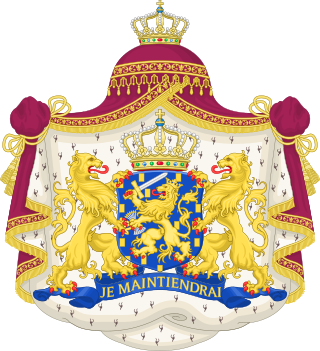
The House of Orange-Nassau is the current reigning house of the Netherlands. A branch of the European House of Nassau, the house has played a central role in the politics and government of the Netherlands and elsewhere in Europe, particularly since William the Silent organised the Dutch Revolt against Spanish rule, which after the Eighty Years' War (1568–1648) led to an independent Dutch state. William III of Orange led the resistance of the Netherlands and Europe to Louis XIV of France and orchestrated the Glorious Revolution in England that established parliamentary rule. Similarly, Queen Wilhelmina of the Netherlands was instrumental in the Dutch resistance during World War II.

Maurice of Orange was stadtholder of all the provinces of the Dutch Republic except for Friesland from 1585 at the earliest until his death on 23 April 1625. Before he became Prince of Orange upon the death of his eldest half-brother Philip William on 20 February 1618, he was known as Maurice of Nassau.
Nassau, derived from the town of Nassau on the Lahn River in Rhineland-Palatinate, Germany, gained historical significance through the House of Nassau. The noble dynasty later formed the Dutch royal House of Orange-Nassau following William I's inheritance of the Principality of Orange in 1544, leading to the adoption of the name Nassau across various locations and institutions worldwide. The name traces its etymology to German nass (wet) and Au(e) (floodplain).

The flathead catfish, also called by several common names including mudcat or shovelhead cat, is a large species of North American freshwater catfish in the family Ictaluridae. It is the only species of the genus Pylodictis. Ranging from the lower Great Lakes region to northern Mexico, it has been widely introduced and is an invasive species in some areas. The closest living relative of the flathead catfish is the much smaller widemouth blindcat, Satan eurystomus, a cavefish.

Katzenelnbogen is the name of a castle and small town in the district of Rhein-Lahn-Kreis in Rhineland-Palatinate, Germany. Katzenelnbogen is the seat of the Verbandsgemeinde Aar-Einrich.

Kittatinny Mountain is a long ridge traversing primarily across Sussex County in northwestern New Jersey, running in a northeast-southwest axis, a continuation across the Delaware Water Gap of Pennsylvania's Blue Mountain. It is the first major ridge in the far northeastern extension of the Ridge and Valley province of the Appalachian Mountains, and reaches its highest elevation, 1,803 feet, at High Point in Montague Township. Kittatinny Mountain forms the eastern side of Wallpack Valley; the western side comprises the Wallpack Ridge (highest elevation: 928 feet above sea level.

Puncak Trikora is a 4,730 or 4,750-metre-high (15,584 ft) mountain in the Highland Papua province of Indonesia on New Guinea. It lies in the eastern part of the Sudirman (Nassau) Range of the Maoke Mountains.

Nassau is a town located in the German state of Rhineland-Palatinate. It lies on the lower course of the Lahn River, on the mouth of the Mühlbach, between Limburg an der Lahn and the spa town of Bad Ems, and is located in the Nassau Nature Park, surrounded by the Westerwald to the north and the Taunus to the south. The town is on the German-Dutch holiday road, the Orange Route. As of 2021, it had a population of 4,592.

HNLMS Johan Maurits van Nassau, named after John Maurice of Nassau, was a Dutch gunboat that served in the early part of World War II, when it was sunk. She was the sole ship of her class, which was developed from the earlier Flores class.
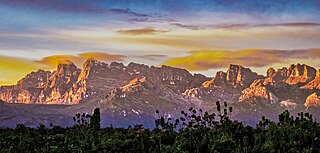
The Sudirman Range, also known as the Snow Mountains, Dugunduguoo, or Nassau Range is a mountain range in Central Papua province, Indonesia. It is named after the first armed forces commander-in-chief and Indonesian national hero Sudirman. It comprises a western portion of the Maoke Mountains. The highest peak in Oceania and Australasia, Puncak Jaya, is located here, as well as the large Grasberg copper and gold mine, operated by the Freeport company based out of the United States. Other peaks of the Sudirman Range are:
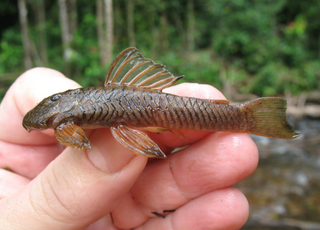
Guyanancistrus is a genus of suckermouth armored catfishes.

Langatabiki is a Paramacca village in the Sipaliwini District of Suriname. Langatabiki is the residence of the granman of the Paramaccan people. Langatabiki is located in the Pamacca resort which was created on 11 September 2019 out of Tapanahony.

Guyanancistrus nassauensis is a species of catfish belonging to the family Loricariidae, the suckermouth armored catfishes. It is discovered in 2005 and formally described in 2018. G. nassauensis is a rare species, highly endemic to the Nassau Mountains in Suriname, and is threatened with extinction by proposed or ongoing mining activities.
The Oranje Mountains is a mountain range in the Sipaliwini District of Suriname. It is named after the House of Orange-Nassau. Mountains on this range include the Roseveltpiek.
'Pseudancistrus' megacephalus is a species of catfish in the family Loricariidae. It is of uncertain and disputed classification.

Guyanancistrus brevispinis is a species of catfish in the family Loricariidae. It is a freshwater fish native to South America, where it occurs in the Atlantic coastal drainages of the Guianas, ranging from the Nickerie River basin to the Oyapock basin in French Guiana and Suriname. It has also been reported from Guyana, but this is believed to be a misidentification. The species is considered the most common and abundant member of the genus Guyanancistrus, occurring in rocky streams with flowing water, especially in the vicinity of plunging waters. It is known to coexist with members of the genus Lithoxus in small forested creeks as well as rapids. The species reaches 14.2 cm in standard length.

Guyanancistrus brownsbergensis is a species of catfish in the family Loricariidae. It is native to South America, where it occurs in the upper Kumbu Creek, which is part of the Saramacca River basin, in Brownsberg Nature Park in the Brownsberg Mountains in Suriname. The type locality of the species is a small mountain stream with a width of 2.5 to 3.7 m, a depth of 28 to 50 cm, a temperature of 23.1 to 23.2 °C, an oxygen concentration of 7.08 to 7.72 g/mL, an oxygen saturation of 93% to 96%, a pH of 7 to 7.5, a conductivity of 30.8 to 31.6 μS/cm, and a current strength of 0.29 to 0.56 m/s. The stream has clear water and a substrate composed of sand, gravel, pebbles, bedrock, and boulders, and overhanging vegetation, leaf litter, and woody debris are present. The species reaches 6.4 cm in standard length. It is known that the habitat of the species is threatened by illegal gold mining.
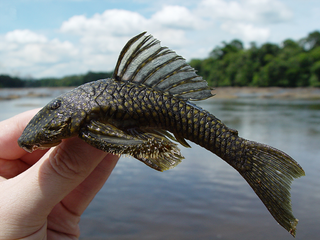
Guyanancistrus longispinis is a species of catfish in the family Loricariidae that is of disputed classification. It is native to South America, where it occurs in the Oyapock basin in French Guiana. It is typically seen in shallow rapids with rocky substrates and moderate levels of illumination. It is known to occur alongside the species Guyanancistrus brevispinis, Harttia fowleri, and Crenicichla ternetzi, as well as members of the genus Ancistrus. The species reaches 10.4 cm in standard length and may be a facultative air-breather.

Guyanancistrus tenuis is a species of catfish in the family Loricariidae. It is native to South America, where it occurs in a forested tributary of the Mapaoni River in the upper Jari River basin in French Guiana, near the Mitaraka Massif, which is a prominent massif in the area. The environment in which the species is typically found is a shallow mountain creek with medium to strong currents, a depth of 20 to 60 cm, and some pools. The species reaches 9.1 cm in standard length. Its specific epithet, tenuis, is derived from Latin and refers to its slender body.
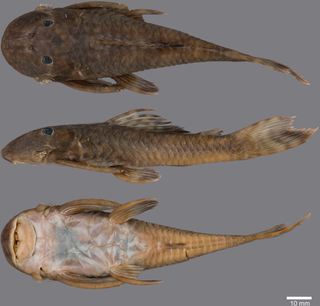
Guyanancistrus teretirostris is a species of catfish in the family Loricariidae. It is a freshwater fish native to South America, where it occurs in the upper Paru de Oeste River in Brazil. The species reaches 9.8 cm in standard length. Its specific epithet, teretirostris, is derived from Latin and refers to the rounded shape of the species' snout.


















